Efficacy of the Si-Washer in Cleansing Gynaecological Laparoscopic Instruments: A randomized controlled trial
Main Article Content
Abstract
Objectives: This study aimed to evaluate the efficacy of the ‘Si-Washer’ in cleansing gynaecological laparoscopic instruments.
Materials and Methods: The instruments were randomized into either a control group or an experimental group using a block randomization method, with sequences securely concealed in sealed envelopes. The control group underwent traditional manual cleansing, whereas the experimental group utilized the Si-Washer.
Results: A total of 302 instruments were randomized, with 151 allocated to each group. The median operative duration was 135.0 minutes (interquartile range [IQR] 115.0–175.0), and the median blood loss was 50.0 mL (IQR 20.0–100.0). No significant differences were observed between the groups regarding diagnostic parameters, operator expertise, operation types, operative time, instrument types, surgical complications, irrigation volume or blood loss. The Si-Washer achieved 100% cleanliness at an adenosine triphosphate cut-off of <150 relative light units, markedly surpassing the manual method, which achieved 58.9% cleanliness at the same threshold.
Conclusion: The Si-Washer effectively decontaminated gynaecological laparoscopic instruments and alleviating the workload of operating theatre nursing staff.
Article Details

This work is licensed under a Creative Commons Attribution-NonCommercial-NoDerivatives 4.0 International License.
References
Lipscomb IP, Sihota AK, Botham M, Harris KL, Keevil CW. Rapid method for the sensitive detection of protein contamination on surgical instruments. J Hosp Infect 2006;62:141–8.
Lipscomb IP, Sihota AK, Keevil CW. Comparison between visual analysis and microscope assessment of surgical instrument cleanliness from sterile service departments. J Hosp Infect 2008;68:52–8.
Alfa MJ. Monitoring and improving the effectiveness of cleaning medical and surgical devices. Am J Infect Control 2013;41:S56–9.
Chen A, Zou X, Tan Y, Chen Y, Ye X, Hao S. Multicenter comparative study of three ‘non-destructive’ methods of detecting the cleanliness of the da Vinci surgical robotic instrument. Gland Surg 2021;10:3305–13.
Nante N, Ceriale E, Messina G, Lenzi D, Manzi P. Effectiveness of ATP bioluminescence to assess hospital cleaning: a review. J Prev Med Hyg 2017;58:E177–E83.
Ling ML, Lim JT, Goh MM. Cleaning verification in medical device reprocessing: Is this required? Can J Infect Control 2015;30:237–8.
Alfa MJ, Nemes R, Olson N, Mulaire A. Manual methods are suboptimal compared with automated methods for cleaning of single-use biopsy forceps. Infect Control Hosp Epidemiol 2006;27:841–6.
de Camargo TC, Almeida A, Bruna CQM, Ciofi-Silva CL, Pinto FMG, Graziano KU. Manual and Automated Cleaning Are Equally Effective for the Removal of Organic Contaminants From Laparoscopic Instruments. Infect Control Hosp Epidemiol 2018;39:58–63.
Alfa MJ. Medical instrument reprocessing: current issues with cleaning and cleaning monitoring. Am J Infect Control 2019;47S:A10–A6.
Evangelista SS, Guimaraes NR, Garcia NB, Santos SGD, Oliveira AC. Effectiveness of manual versus automated cleaning on Staphylococcus epidermidis biofilm removal from the surface of surgical instruments. Am J Infect Control 2020;48:267–74.
Rowan NJ, Kremer T, McDonnell G. A review of Spaulding’s classification system for effective cleaning, disinfection and sterilization of reusable medical devices: Viewed through a modern-day lens that will inform and enable future sustainability. Sci Total Environ 2023;878:162976.
Kenters N, Tartari E, Hopman J, El-Sokkary RH, Nagao M, Marimuthu K, et al. Worldwide practices on flexible endoscope reprocessing. Antimicrob Resist Infect Control 2018;7:153.
Dancer SJ, King MF. Systematic review on use, cost and clinical efficacy of automated decontamination devices. Antimicrob Resist Infect Control 2021;10:34.
Alfa MJ, Nemes R. Manual versus automated methods for cleaning reusable accessory devices used for minimally invasive surgical procedures. J Hosp Infect 2004;58:50–8.
Ling ML, Ching P, Widitaputra A, Stewart A, Sirijindadirat N, Thu LTA. APSIC guidelines for disinfection and sterilization of instruments in health care facilities. Antimicrob Resist Infect Control 2018;7:25.
Committee AT, Parsi MA, Sullivan SA, Goodman A, Manfredi M, Navaneethan U, et al. Automated endoscope reprocessors. Gastrointest Endosc 2016;84:885–92.
Benowitz I, Moulton-Meissner HA, Epstein L, Arduino MJ. The Centers for Disease Control and Prevention Guidance on Flexible Gastrointestinal Endoscopes: Lessons Learned from Outbreaks, Infection Control. Gastrointest Endosc Clin N Am 2020;30:723–33.


